What is Salmon En Papillote Made Of? A Complete Guide to This Classic French Dish
Salmon en papillote is a classic French dish that involves baking salmon fillets wrapped in parchment paper. The steaming process within the paper pouch allows the fish to cook gently in its own juices while absorbing robust flavors from fresh herbs, vegetables and citrus. When unwrapped tableside salmon en papillote releases an enticing aroma, revealing moist, tender salmon brimming with taste.
While elegant, salmon en papillote is surprisingly easy to make at home. We’ll walk through everything that goes into this impressive dish.
A Brief History of Salmon En Papillote
Salmon en papillote originated in France, where “en papillote” refers to the general cooking technique of baking ingredients wrapped in paper. Parchment paper was often used for its resilience at high heat. While the method works for many foods, salmon en papillote became one of the most well-known papillote dishes.
The parchment paper pouch creates the ideal self-contained environment for gently steaming the salmon. As it bakes, the fish combines with its own juices and other flavorful ingredients like lemon, fresh herbs, and vegetables. The end result is salmon that is perfectly cooked and infused with aromatic flavors. The show-stopping moment of opening the papillote packages tableside reveals salmon at its finest.
The Essential Ingredients
The main components that come together to create classic salmon en papillote include:
-
Salmon – Wild-caught salmon fillets such as king, sockeye, and coho work best. Their rich flavor shines through
-
Parchment Paper – Essential for forming the sealed cooking pouch around the salmon and vegetables. It can be cut into fun shapes.
-
Vegetables – Thin slices or dices of vegetables like tomatoes, spinach, zucchini, onions, and bell peppers add moisture.
-
Lemon – Brightens flavor and prevents dryness. Thin slices or a lemon juice squeeze are ideal.
-
Herbs – Fresh soft herbs like dill, parsley, tarragon, and basil add aromatic flavor.
-
Olive Oil or Butter – Adds richness and prevents sticking. Use just a drizzle or small dollop.
-
Salt and Pepper – Balances flavors and gives the necessary finishing touch.
Step-By-Step Method
Follow these simple steps for perfect salmon en papillote every time:
-
Cut parchment paper into a heart or oval shape. Fold in half to crease. Open back up.
-
On one half, layer sliced veggies, lemon, herbs, salmon, salt, and pepper.
-
Drizzle with olive oil or dot with butter.
-
Fold over the second parchment half and seal edges by making small folds all around.
-
Bake at 400°F for 10-15 minutes until salmon is cooked through.
-
Remove from oven, place packet on plate, and open at the table for an aromatic presentation.
Helpful Cooking Tips
-
Tightly seal the paper parcel with overlapping folds so moisture and flavor stay locked in.
-
Place parchment packets on a baking sheet to easily transfer in and out of the oven.
-
For 1-inch thick salmon fillets, 10-15 minutes is sufficient cooking time. Adjust as needed.
-
Don’t peek and release steam! Opening the pouch reduces moisture.
-
Let rest 1-2 minutes before opening to allow heat to distribute evenly.
Creative Serving Suggestions
Salmon en papillote makes for beautiful presentation when served in its parchment pouch. Wow your guests with these ideas:
-
Place unopened parcels on plates for guests to discover the contents. Provide scissors to easily open.
-
For restaurant-style reveal, slit open the top of each packet, pull open sides, and garnish with herb sprigs.
-
Make individual portions in smaller pouches for fun single-serving meals.
-
Use larger parchment sheets, add sides of greens and grains, and serve family-style.
-
Pair with rice, potatoes, or bread to complete the meal.
-
Drizzle with vinaigrettes, aioli, or Hollandaise sauce for added richness.
Infinite Flavor Possibilities
While lemon and herbs are classic, get creative with customized flavors:
-
Citrus – Lime, grapefruit, orange, Meyer lemon
-
Herbs – Basil, cilantro, rosemary, thyme
-
Spices – Curry powder, ginger, za’atar
-
Vegetables – Spinach, tomatoes, mushrooms, potatoes
-
Fruits – Mango, pineapple, stone fruits
-
Sauces – Pesto, chimichurri, harissa
Why Make Salmon En Papillote?
This cooking technique offers many benefits:
-
Ensures tender, flaky, super moist salmon
-
Allows gentle steaming with robust flavors
-
Minimizes cleanup with no pots or pans
-
Fun and elegant presentation to impress guests
-
Easy weeknight meal that looks gourmet
-
Infuses salmon with tons of flavor
Salmon en papillote takes simple ingredients and transforms them into a sensational dish. With just some basic components and the easy parchment paper wrapping method, you can master this classic French recipe. The fantastic aromas, textures, and flavors make it a great technique to add to your cooking repertoire.

Three Ways to Crimp the Parchment Paper Shut:
Folding Style #1: For my favorite method, I prefer to use a 13″ x 16″ pre-cut rectangular sheet of parchment paper (affiliate), then fold the long edge over a few times, as shown below:
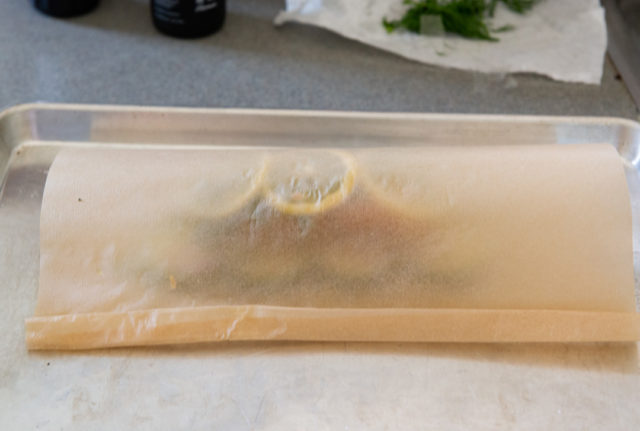
Once the long edge is done, fold in the sides of the parchment sheet:
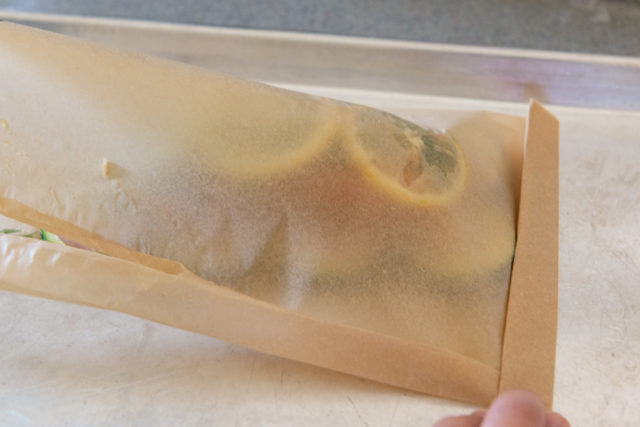
Then, to make sure the edges don’t come undone, I tuck them underneath, so that the weight of the fish and ingredients holds the parchment paper pouch ends down:

Folding Style #2: You can take the same rectangular sheet of parchment paper, and repeatedly fold in the edges in a half moon shape.
In this case, the crimping holds pretty well, so you don’t have to tuck the paper underneath the fish.
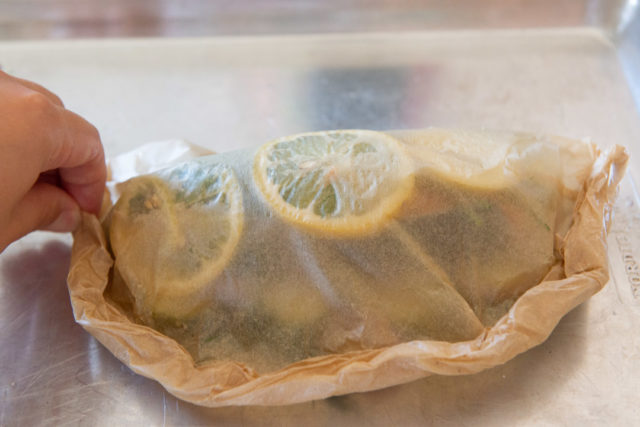
I don’t like the look as much but this is merely personal preference.
Folding Style #3: Parchment Bags are sold at most grocery stores now. You can see below, it’s a big bag that you can put in fish, meats, etc, then simply fold the end over a few times:
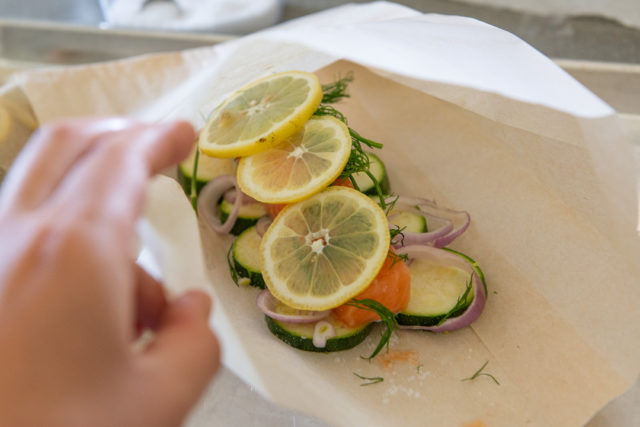
I tested out some of these bags, but still prefer using a rectangular sheet of parchment paper because it’s harder to properly season the ingredients and layer them. But I realize this may be personal preference as well.
Other Types of Fish You Can Try
While salmon filets are my favorite, you can also experiment with substituting other kinds of fish like Mahi Mahi, Arctic Char, Snapper, Barramundi, and Cod.
Season the fish with kosher salt and fresh ground pepper, then add fresh dill on top:

Fresh dill is my favorite of the fresh herbs for salmon, but oregano is also a good choice.
Finally, lay some thinly sliced fresh lemon on top of the dill layer:
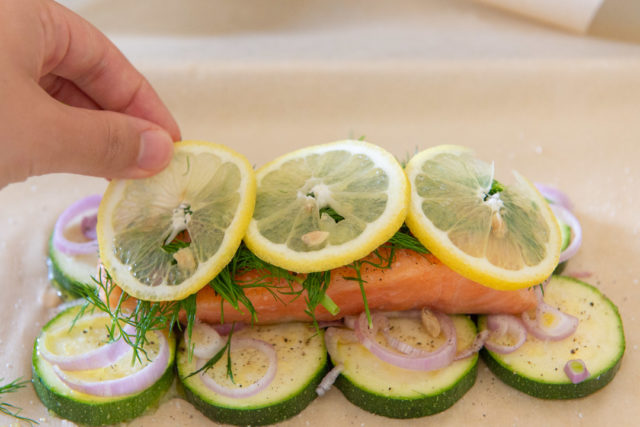
I love the look of the lemon slices on top, but they aren’t meant to be eaten in the final dish.
If that’s an issue for you, you can simply add a 1/2 teaspoon of lemon zest and 1 tablespoon of lemon juice on top of the salmon.
That’s it for the ingredients. Time to seal the parchment!
How to Make Salmon En Papillote | ZLINE Chef Series
FAQ
What is salmon en papillote?
Salmon cooked en papillote, which means wrapped in a packet of parchment (or foil), is a dramatic way to procure perfectly cooked salmon, but it isn’t difficult. Fold a fillet into a cut piece of parchment, and then layer it with seasonings or perhaps vegetables or citrus fruit. Then simply bake the packets until done.
What is a papillote made of?
“En papillote” refers to a cooking method where ingredients – often including fish – are placed in a bag made of parchment paper before being baked in an oven. The packet can also contain veggies, butter, fresh herbs, a slice of lemon, etc.
What are the disadvantages of en papillote?
The bag puffs up nicely during this process, so at least you can tell when the steaming is underway. The main disadvantage being that there’s no way to rescue an undercooked bag, so fish is the ideal content – it being fairly difficult to disasterously undercook fish.
What is the point of en papillote?
En papillote (French pronunciation: [ɑ̃ papijɔt]; French for “enveloped in paper”), or al cartoccio in Italian, is a method of cooking in which the food is put into a folded pouch or parcel and then baked. This method is most often used to cook fish or vegetables, but lamb and poultry can also be cooked en papillote.
